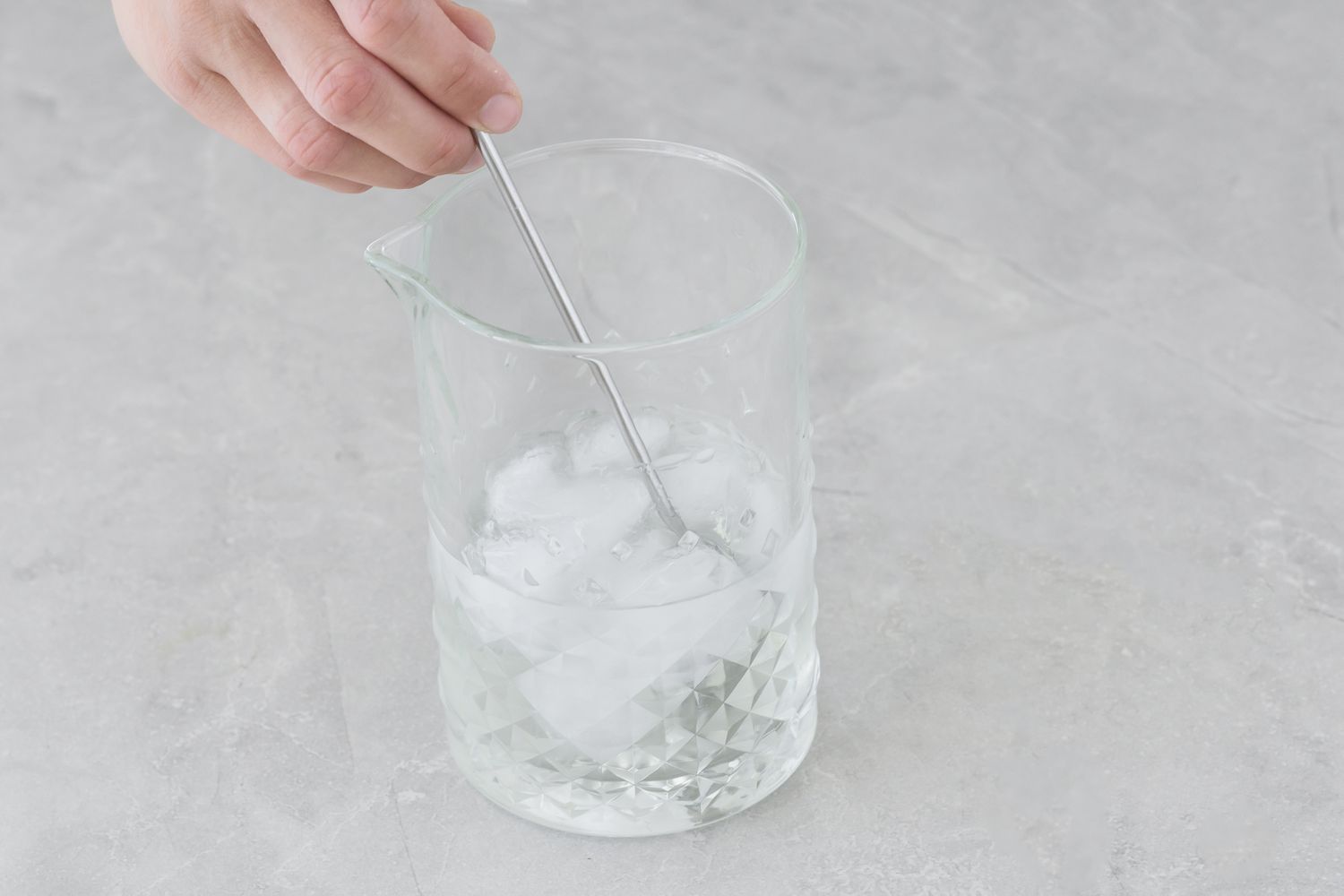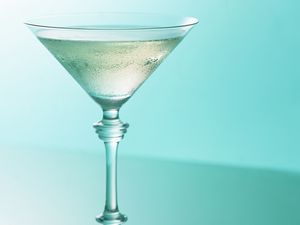A classic dry gin martini is iconic and could possibly be the world's most popular cocktail. Though many "martinis" have been created, there's only one true martini, and few drinks can beat this simple recipe. You only need a couple of key ingredients and 30 seconds to stir (not shake!) one up. The botanical flavor bouquet has a dry profile that you can adjust to your taste.

The Spruce Eats / Katarina Zunic
It's Personal
There's no mystery to the martini—all you need to make one is your best gin and dry vermouth. There are countless ways to adjust the formula and technique: Gin or vodka, dry or wet, dirty or clean, shaken or stirred, olive or lemon garnish. All of these options have spurred a debate over the "proper" way to make a martini. While it's a never-ending discussion, the only correct answer is how you enjoy it. After all, you're the person drinking it.
Martini Statistics
With all of the different variations of the martini, it's fascinating to see how others prefer to mix it up. Over a nine-year period, The Spruce Eats did an informal poll to see how drinkers take their martinis, and the results are rather interesting. Of the 90,000 people who responded, over half (59 percent) preferred gin over vodka. The overwhelming majority of those drinkers enjoy a full dose of vermouth, and only 13 percent prefer little or no vermouth.
Whether it included gin or vodka, there was a slim majority (52 percent) who shook their martinis versus stir. This is interesting, considering the classic advice regarding when to shake or stir cocktails. In general, bartenders stir liquor-only drinks, saving the shake for more complex and mixer-heavy cocktails.
Customizing Your Martini
The traditional options are not your only choices. Many martini fans put their personal spin on preparing it. Chilling one or both bottles in the refrigerator is among the most common, with some dedicated martini drinkers actually storing their bottles in the freezer. This ensures that the gin and vermouth are always cold and any dilution from ice is avoided. This approach will produce the most flavorful martini possible. However, without dilution, the drink will remain bottling-proof and may be way too strong for some people.
Shake it Up
A small amount of water relaxes the drink and marries the botanical flavors. Shaking the martini with ice adds more dilution and further softens the taste, which may explain why many drinkers prefer this.
Experimenting with this classic cocktail will help you figure out exactly how to make "the best martini" for your taste. Most of this will be adjusting the gin-to-vermouth ratio, exploring different brands, and choosing your preferred garnish. It's not a bad task to undertake, and you may join the ranks of devoted martini connoisseurs.
Chilling the Glass
What's the benefit of chilling the cocktail glass?
Tips for Making the Best Gin Martini
- Use quality ingredients—The key to a great martini is to pour quality ingredients, so start off with a top-shelf gin and vermouth. With only two ingredients, this is not a cocktail where you want to be frugal.
- Adjust the ratio—Each gin is different. You may want to change the ratio and the garnish when switching from one brand to another.
- Expiration dates—Vermouth has a short shelf life because it's a fortified wine, not a distilled spirit. If your bottle has been open for longer than three months, it's time to replace it.
- Garnishes—It's thought that the lemon twist is the original martini garnish. The olives may have become an option when vodka was introduced as a gin substitute.
- Number of olives—For the olive garnish, skewer either one or three olives on a cocktail pick or simply drop them in the glass. It's an old bar tale that an even number of olives is bad luck.
- Don't overdo it—If the olives are big or stuffed with jalapeños, garlic, or the like, one olive will usually do. The flavor of the olive will slowly infuse into the drink and add just a little more dimension as it rests.
- Chill the glasses—Last but certainly not least, take some time to chill the cocktail glass for the best possible result.
"The martini is about as easy a drink as possible. It takes a little trial and error to find your personal perfect version. This recipe is a great place to start. Don't overlook the importance of vermouth! It's what makes it a cocktail rather than just straight booze." —Tom Macy

Ingredients
-
2 1/2 ounces gin
-
1/2 ounce dry vermouth, or to taste
-
1 dash orange or aromatic bitters, optional
-
Lemon twist or 1 or 3 olives, for garnish
Steps to Make It
-
Gather the ingredients. Chill a cocktail glass.
![Ingredients for a classic gin martini gathered]()
The Spruce Eats / Katarina Zunic
-
In a mixing glass filled with ice cubes, combine 2 1/2 ounces gin and 1/2 ounce dry vermouth, pouring more or less vermouth to your taste.
![Gin and vermouth combined in a mixing glass with ice]()
The Spruce Eats / Katarina Zunic
-
Stir for 30 seconds.
![Gin martini ingredients being stirred in the mixing glass]()
The Spruce Eats / Katarina Zunic
-
Strain into the chilled cocktail glass.
![Straining the gin martini into a chilled cocktail glass]()
The Spruce Eats / Katarina Zunic
-
Add 1 dash orange or aromatic bitters, if desired.
![Orange bitters being added to gin martini]()
The Spruce Eats / Katarina Zunic
-
Garnish with a lemon twist or 1 or 3 olives.
![Classic gin martini garnished with olives on toothpicks]()
The Spruce Eats / Claire Cohen
Feeling Adventurous? Try This:
It's one drink, yet there are so many options. Among those are a few common recipes, and each has its own name:
- Dry Martini: Traditionally, this uses more dry vermouth, which seems to be the most logical approach. However, today's dry martini is typically defined as using little or no vermouth; a "wet" martini uses more vermouth.
- Bone Dry or Desert Martini: Used for times when you want to clarify that no vermouth makes it into the mix. Essentially, you're drinking chilled gin. It's said that Winston Churchill made his martinis by merely chilling gin and bowing in the direction of France, where dry vermouth originated.
- 50-50 Martini: The ultimate "wet" martini, this recipe uses equal parts of gin and dry vermouth.
- Perfect Martini: Get a slightly sweeter profile by using equal parts of sweet and dry vermouth.
- Vodka Martini: Replace the gin with vodka. This is popular among drinkers who don't necessarily enjoy the "piney flavor" of gin.
- Gibson: Nothing changes from the original gin martini except the garnish. This cocktail makes use of those tiny cocktail onions.
- Dirty Martini: Add a small amount of olive brine or juice to give the drink a salty-savory twist.
How to Make Martinis for a Crowd
To make a large batch of martinis for a party, follow these steps:
- Make one martini and measure its volume in ounces before and after stirring with ice and straining. The difference between the numbers is the amount of water that is incorporated into the drink.
- Multiply the gin, vermouth, and water by the number of servings you want to make.
- Use the resulting numbers to help you figure out how many bottles of each ingredient you'll need to buy. Remember that alcohol is usually sold in 750mL bottles. 750mL is approximately 25 1/4 ounces.
- Once you have your ingredients, measure them out according to the math you did in Step 2.
- Mix the ingredients together, place in a serving vessel, and chill well.
- To serve each drink, measure out the amount of cocktail you recorded in step 1 after being stirred with ice and strained. Pour into a cocktail glass. Add the optional bitters if desired. Garnish and serve.
How Strong Is the Martini?
The martini is by no means a light drink. That's why it is served short and rarely poured over 3 or 4 ounces. With the standard 80-proof gin, the martini in this recipe weighs in at around 31 percent ABV (62 proof). Without a doubt, this is one of the strongest drinks you can mix up.
| Nutrition Facts (per serving) | |
|---|---|
| 183 | Calories |
| 0g | Fat |
| 2g | Carbs |
| 0g | Protein |
| Nutrition Facts | |
|---|---|
| Servings: 1 | |
| Amount per serving | |
| Calories | 183 |
| % Daily Value* | |
| Total Fat 0g | 0% |
| Saturated Fat 0g | 0% |
| Cholesterol 0mg | 0% |
| Sodium 2mg | 0% |
| Total Carbohydrate 2g | 1% |
| Dietary Fiber 0g | 0% |
| Total Sugars 0g | |
| Protein 0g | |
| Vitamin C 0mg | 0% |
| Calcium 1mg | 0% |
| Iron 0mg | 0% |
| Potassium 15mg | 0% |
| *The % Daily Value (DV) tells you how much a nutrient in a food serving contributes to a daily diet. 2,000 calories a day is used for general nutrition advice. | |
Recipe Tags:

:max_bytes(150000):strip_icc()/tom-macy-4845864-1bdb007179ff48ea9f48a10c9c94b936.jpg)





















